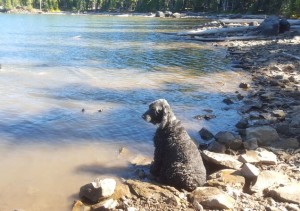“Dashiell has a large abdominal mass,” the vet said in a soft, matter-of-fact voice tinged with empathy. “The x-ray isn’t showing what it’s attached to, but it needs to go.”
 I looked at my dog who just that morning had been prancing in the park showing off his ball to anyone who cared to notice.
I looked at my dog who just that morning had been prancing in the park showing off his ball to anyone who cared to notice.
“He’s so strong and vigorous. Why do this surgery now?”
“This is exactly when you want to do it,” the vet said, explaining that at 13, my pup’s odds for surviving were already compromised. He needed all his strength and then some to get through this.
Just four days before, we’d hiked up to a lake. Dashiell jumped over—and squirmed under—fallen trees the whole way up. He ran with the other dogs, returning to check on me before taking off again. Once he hit the water, he turned into deaf dog, ignoring me completely and eventually bounding the wrong way around the lake as I stood with the other three pups waiting to head back down the hill. All this with a tumor in his belly?
I knew that the surgery might kill him. I also knew that the mass could rupture at any time, which would mean no more hikes or log hopping. The only thing worse than death, I realized, would be a slow decline during which he would not be able to do what he loved or be the dog he is. So I did what I had to do.
“The next 24 hours will be touch and go,” the vet tech told me when I picked up Dashiell the afternoon after his surgery. “The mass was 4 ½ pounds. It was attached to his spleen so we had to take that out too. He’s lost a lot of blood in addition to more than 10 percent of his body weight.”
I went into doggy-nurse mode, moving a mattress onto the living room floor so I could lie next to the dog crate that would keep him still and prevent him from inadvertently being tromped on by the other dogs. Every time he heard him move, I forced myself to get up and load canned dog food onto a spoon. He couldn’t have much food at a time, but he needed to regain his strength. If that meant feeding him throughout the next two nights or more, that was okay with me.
Within days, post-surgical Dashiell went from not being able to lift his head to being my prancing boy again. He even seemed to like the tee-shirt that kept him from licking his wound or tearing out his stitches. And I could breathe again.
So what does all this have to do with writing, you ask? Sometimes manuscripts that seem to be working fine harbor a defect that can prove detrimental if not fatal. It’s easy to ignore the signs. With Dashiell, I had noticed that he suddenly seemed to have a little pot belly, but I figured that a 13-year-old pup was entitled. So I didn’t worry about it when I should have. When the vet examined the mass, he found that two nodules had ruptured. In time that would have killed my pup.
Since the surgery, Dashiell has come up to me, his tail wagging and his licking machine (otherwise known as the fastest tongue in the West) turned to high. It’s as if he’s thanking me for relieving him of his tumor.
While a manuscript can’t exactly show gratitude in the same way, cutting out a section that doesn’t belong, however painful and scary, can give it life as well. So when it doubt, cut it out.



Sorry, comments are closed for this post.